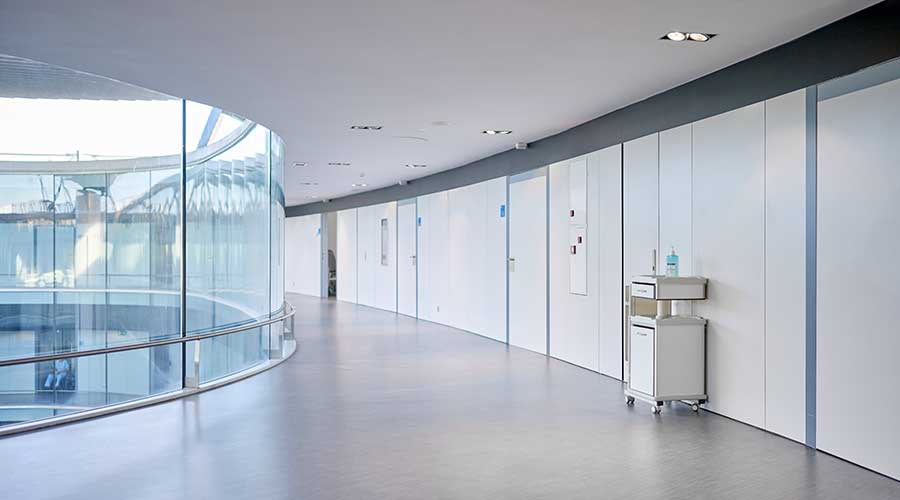Digital transformation is the key to creating smart hospitals that maximize staff’s time for the best patient care possible. With competition at an all-time high in the healthcare industry, providing an optimized patient experience can help hospitals stand out and add to their value proposition.
By integrating systems and technologies like HVAC, building automation systems (BAS), lighting, security, clinical systems and more, hospital leaders can streamline workflow for staff while delivering an elevated patient experience.
Technology can completely revolutionize how doctors and nurses provide care. For instance, consider a code blue emergency; when systems are integrated, the patient room responds to the code blue even by automatically preparing the room to save a life.
The moment a code blue is initiated, HVAC thermostat override takes effect, forcing maximum cold air to the room immediately to keep patients and staff comfortable as the room fills with people lighting increases to improve visual acuity, shades for privacy, and monitors present vital patient information. The precious time saved by this integration can potentially save lives.
Becoming a truly smart healthcare facility from top to bottom requires a holistic approach that looks beyond the physical infrastructure. The vision and purpose for the building should drive the planning, design, construction and operations in order to achieve business outcomes.
But starting a digital transformation can be daunting, especially in the healthcare industry; hospitals and clinical facilities have complex technology ecosystems, where one decision can snowball into a whole host of others. And in such a sensitive environment, construction can be a frustrating distraction for staff and patients. But with a comprehensive five-tiered approach, any digital transformation can proceed smoothly, on time and on-budget.
Evaluate existing systems and identify opportunities for improvement – Before any decisions are made or technology is implemented, all digital transformations should begin with an evaluation of the legacy systems and technologies already in place. This is an opportunity to analyze what works, what requires
improvement or maintenance, and what is missing from a healthcare facility’s infrastructure. Working with your technology master planning partner, it’s important to conduct that evaluation with IT, facilities, and clinical perspectives in mind to ensure that all three are represented in an eventual plan.
For instance, smart lighting systems act as a crucial integration point for other technologies. Establishing if your facility is missing this piece of the puzzle can save you time further down the road. Examining a healthcare facility from a clinical, IT and building systems perspective allows technology planners to catalog any gaps in the systems.
Conduct a needs assessment to determine the most effective technologies for future-proofing your facility – To create a smart hospital that delivers the best experience for patients, it’s critical to perform a needs assessment amongst those who will be caring for them.
Take the time to interview doctors, nurses and other staff members to determine each department’s unique set of needs. Are nurses spending too much time adjusting patients’ room environment? Are doctors unable to locate their colleagues quickly? Considering the end user is key to ensuring overall staff and patient satisfaction in the long-term.
An important part of this process is to ensure maximized investment by right sizing the technology. This can be achieved through that same collaboration, building use cases that reflect the intended use of the technology. With these established needs and projected use cases in mind, qualitative key performance indicators (KPI’s) can be set to guide technology selection.
Identify integration opportunities and create a roadmap – With your existing infrastructure and staff needs established, work with the technology design team to create your project roadmap. Begin by determining what can be achieved by simply changing processes, what requires new technology implementation and what can be solved by a combination of both.
Once you have mapped out the processes, technologies and testing needed, you can begin an integrated delivery methodology. With the engineering design specifications, integration maps and budgets for all building, business and clinical systems in hand, the thoughtful design and intentional integration of systems can be implemented to help achieve desired outcomes.
In addition, establishing ownership for executing the technology vision at this stage is important to keep the project on track, especially ownership of integration. This roadmap must be agreed upon by all stakeholders, as it will shape the execution of the entire digital transformation.
Execute solutions and integrations bearing in mind overall project goals – Well-executed technology construction delivers on-time, on-budget implementation of the enterprise technology vision and design, including complete Day 1 functionality of all building, business and clinical systems. Hospitals and clinics are complicated ecosystems, meaning one decision can have a ripple effect on the surrounding infrastructure. Keeping all stakeholders and parties unified throughout the implementation project, avoiding any distracting side projects in the process, ensures the initial vision is not lost.
Communication amongst stakeholders is integral at this stage.
Identify a single point of responsibility to ensure ongoing holistic service and accountability – technologies might be implemented, but the project is still ongoing. Integration testing at this stage is critical, especially during the first two weeks of the project. If there’s an issue, it’s more likely the integration than the technology. Testing integrations now ensures long-term reliability.
A smart, digitally transformed building can only continue to fulfill the purpose for which it was created if the systems, platforms and technologies implemented within are maintained and optimized for the future. Technology lifecycle services ensure that business and building outcomes are sustained, the holistic continuity of systems is provided throughout the building’s lifecycle, and performance levels are delivered through proactive detection and resolution of issues.
Digital transformation for the future-minded healthcare facility
When a digital transformation follows this five-tiered approach, the result is a highly efficient, connected, secure and intelligent healthcare facility. However, a healthcare facility’s digital transformation is never truly complete; it is an ongoing process, adapting to patients’ and staff’s changing needs and evolving industry innovations. This cyclical nature makes adhering to an efficient and streamlined approach crucial to ensuring the project proceeds smoothly. By evaluating existing technology infrastructure, performing a needs assessment, creating a technology roadmap, executing implementation and integration of systems, and committing to ongoing testing and service, the best results can be achieved.
Brendon Buckley is the Senior Director for Healthcare and Technology for Johnson Controls.

 Healthcare Facilities Look to Future-Proof Facilities
Healthcare Facilities Look to Future-Proof Facilities Yale New Haven Health Experiences Data Breach
Yale New Haven Health Experiences Data Breach Rethinking Facilities: A New-Generation Approach to Behavioral Healthcare
Rethinking Facilities: A New-Generation Approach to Behavioral Healthcare ThedaCare to Open Medical Center in Fond du Lac, Wisconsin
ThedaCare to Open Medical Center in Fond du Lac, Wisconsin UF Health Hospitals Rely on Green Globes to Realize Their Full Potential
UF Health Hospitals Rely on Green Globes to Realize Their Full Potential